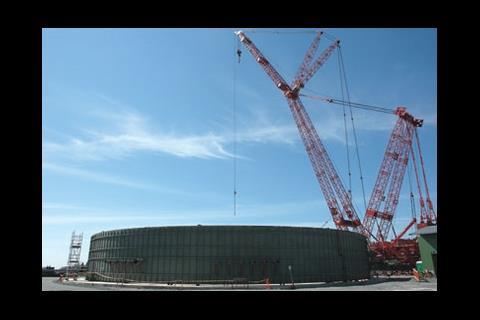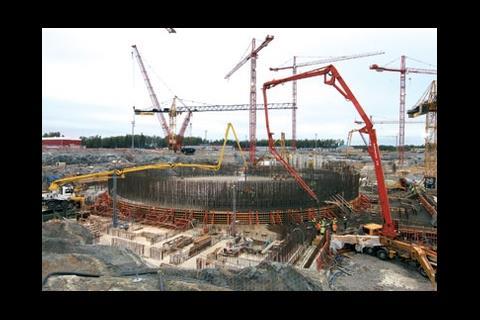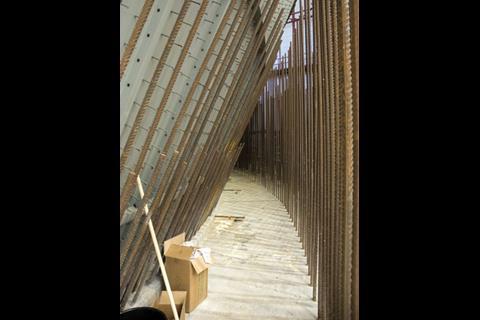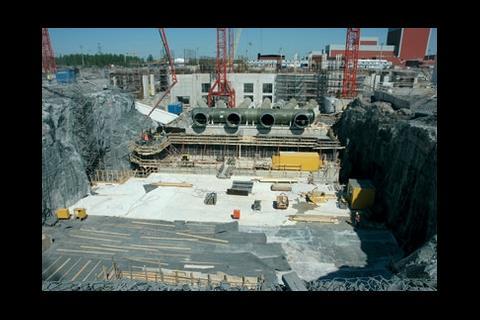320,000 m³ of granite blasted away, 12,000 m³ of concrete poured in one go: the team building Europe's first nuclear reactor in a decade aren't messing around. Still, the most complicated thing is the paperwork. Thomas Lane reports from Finland
It's just as well they widened the road to Olkiluoto. It has to cope with a medium-sized army of construction workers, engineers, government officials and journalists, all travelling the 7.5 miles between the main road and the tip of this remote peninsula on Finland's west coast, where work on Europe's first new nuclear power station in a decade is under way.
Olkiluoto 3 will be the third reactor to be located here, and according to its designers it will be the world's first "third-generation" plant. This means it has been designed to cope with the risks of a post-9/11 world, including a direct hit by a fully loaded airliner. And, unlike its two sisters, it is being built and run without government subsidy.
"Electricity produced by nuclear is more competitive than that produced by any other investment and that includes reprocessing the spent fuel, putting it into the waste repository and closing down the existing plants," says Martin Landtman, senior vice-president on the project for the client, power generation company Teollisuuden Voima Oy.

The plant is based on a design called the European Pressurised Water Reactor, a name that demonstrates the ambitions of its designer, a consortium made up of French company Areva and Germany's Siemens. It would certainly be a model for plants in this country if third-generation nuclear power gets the green light - which is looking increasingly likely (see below - "Britain's nuclear options"). Indeed, Finland is nearing the end of a road on which the UK has just taken its first steps. So what lessons do the Finns have for us?
Compared with them, we have it pretty good when it comes to energy supply. They have to import 67% of their fuel, including coal and gas, from Russia, and their domestic demand is increasing. Furthermore, Finland has no hope of meeting its Kyoto Protocol targets if it opts for fossil fuel power stations and, according to Landtman, 6000 wind turbines would be needed to equal the capacity of Olkiluoto 3. So the Finnish predicament is rather like ours, but with the volume turned up.
Given these constraints, the nuclear option looked attractive to the Finns. But there were two additional factors that tipped the scales in its favour. First, the four nuclear power stations that Finland has now have excellent safety records. And second, TVO claims to have sorted out the waste storage problem - Olkiluoto enjoys particularly stable ground conditions and construction work has started on a repository 500 m underground in which waste will be sealed. According to TVO, this will be unaffected by rising sea levels or any new ice ages - and in any case the radioactivity of the waste will practically have disappeared after a few hundred years."If there was a bad track record and if the fuel could not have been taken care of, it would not have been easy to get approval," says Landtman. This part of the equation will be harder for the UK's politicians to square with the public: power stations in this country have a good record but the waste reprocessing facility at Sellafield has a terrible one, and there is no permanent disposal facility in Britain. Also, in the wake of the bitter CND protests of the 1980s, all things nuclear acquired a sinister glow in the mind of the British public.
The economic case for Olkiluoto 3 was also good. "There is no state subsidy - it's financed purely on free market terms," says Landtman. Twenty per cent of the funding will come from big industrial companies in the form of equity stakes, 5% will be lent to TVO by financial institutions, and the remaining 75% will be loaned directly by private companies. These companies will take the output from the station and either use it themselves or sell it on. Critics have questioned the figures, saying the fixed price of €3.2bn (£2.2bn) has been subsidised by cheap loans - an allegation the European commission is investigating. Despite this, the financing of the plant is radically different from the days of wholesale state subsidy and this financing method could be a model for the UK, as large companies have indicated they would be interested in funding new nuclear here.

The plant is being built as well as designed by the Areva Siemens consortium: Areva is constructing the reactor building and Siemens is responsible for the turbine hall. It is rather like design and build, with one important difference. Nuclear power stations are subject to intensive scrutiny by the regulators to ensure their safety. Every element of the design has to be checked and approved, then checked again to ensure there is no deviation from the specification.
TVO reports to STUK, the Finnish radiation and nuclear safety authority. "The authority only talks to us and has no contract with the consortium so that puts us in the driving seat," says Timo Kallio, senior manager in the construction department. "We check on the design and comment directly."
This process would probably be repeated in Britain. "The way STUK works in Finland would be fairly similar to the way the Nuclear Installations Inspectorate would operate in this country," says David Boath, international reactor development director at Amec NNC, Amec's nuclear division.
The audit process means TVO has to employ an army of people to help. "The amount of documentation issued is huge so we use consulting companies to help," says Kallio. "If I'd known, I'd have formed my own audit company. Everyone is auditing everyone else."
Take concrete. Vast amounts are needed, so a huge batching plant has been put in place, supported by two backup plants with a total capacity of 300 m³ an hour. "The biggest challenge is co-ordinating all the concrete work on the nuclear island as it's all cast in situ. We're casting between 10,000 m³ and 14,000 m³ of concrete a month at the moment," says Kallio. "The logistics and quality of the concrete casting is the key issue to keep on schedule."
Unfortunately, the team found out the hard way how stringent quality control policies can affect a programme. "There was a deviation from the specification in the batching plant - there was too much water in the mix. Technically, it was not a problem, but because it was a deviation it had to be addressed," explains Landtman. "The plant was shut down for eight weeks and procedures were put in place to ensure that this would never happen again."
But it wasn't just a case of more training for the batching plant operatives. The specification of the wet concrete that had been poured had to be checked and documented. "There was a hell of a lot of back documentation and recalculation,"
says Kallio. "The lesson we learned was this was the last time that was going to happen. Everything has to be done before." He points out this is the crucial difference between conventional heavy civil engineering projects and nuclear power schemes. "With conventional construction if you know the product is good, you just continue."
Indeed, the work that has been completed so far doesn't look particularly complicated - apart from the paperwork. But the scale of it is impressive. TVO, which was responsible for preparing the site before handing it over to the consortium, started work at the beginning of 2004. This wasn't just a case of cutting down a few trees: 320,000 m3 of solid granite had to be removed to level the ground and create the hole in which the plant will sit. "You have to explode it - there is no other way," says Kallio. "And we had to bear in mind there were two operating nuclear power plants next door so we had to control the vibrations."
The plant is set deep into the ground so cooling seawater can flow into it through a large channel. Extensive grouting was necessary to waterproof this excavation, as it was up to 14 m below sea level. The channel has been dammed to prevent the site being flooded, and this will be removed at the end of the project. TVO has also built a harbour for ships bringing in materials and a 1.6 km long ringmain to supply services to the site.

Areva and Siemens took over the site in February 2005 with just five years and three months to complete the project. "It's the world's fastest schedule," says Kallio. Work commenced on installing the first of 52,000 tonnes of rebar needed on the project. Much of this will be 42 mm in diameter. "It's the biggest rebar allowed in Finland without special testing."
Once the rebar for the plant's 3.5 m base slab and the lower part of the reactor building walls was in place, concrete pouring could begin. This has been done in three stages, but the bulk of it was done in one go - 12,000 m³. "It was the biggest single casting done in Finland ever," says Kallio. "It was done continuously over six days with a lorry coming from the batching plant every three minutes. It went perfectly."
The next stage was to install the base part of the steel liner, used to make the reactor building gas-tight. The 50 m diameter liner arrived by ship in two halves and has been welded together on site. One of the world's three largest cranes with a lifting capacity of 1600 tonnes was used to lower the liner into position on the slab. "It was a big day when that was lifted," says Kallio.
Work has now started on welding together the next part of the liner, which will sit on the base. There are four intermediate rings of steel sitting on the base and these will be capped by a steel lid.
In an out-of-the-way spot, a team is busy constructing a full-scale mock-up of one corner of the reactor building. This is to work out the most effective way of doing it and to check quality. The reactor has an inner and an outer wall, both more than 1 m thick (See attached - "Reactor section diagram"), and concreting work is due to start this August. Work is also progressing on the building just outside the reactor shell, and construction has started on the turbine hall - the concrete columns for the turbine are in position.
Check and check again
Construction is scheduled to finish at the end of 2007. But that isn't the end of the story: it takes a year to get an operational licence. This involves yet more checking - the authorities sift through the material to make sure the plant has been built properly. The plan is for Olkiluoto 3 to come on stream in 2009, providing the team can claw back a nine-month delay. Problems with the concrete haven't helped, but according to Landtman: "The real reason for the delay is because the detailed engineering designs are delayed. This is because of design changes such as the hardened reactor building shell."
The plan is to work harder. There are two eight-hour shifts a day and this will rise to three if necessary. Work will also be re-sequenced. "We will have to see how these measures work out on site," says Landtman.
Despite these glitches, Olkiluoto 3 can provide good lessons if Blair's government decides to go down the nuclear road: private funding, productive client-contractor relations, bold engineering and a mature approach to auditing. Let's hope the UK is paying attention.
How it works
How it works
The fuel is contained in gas-tight fuel rods in the reactor core. Boron control rods can be raised and lowered to control the rate of reaction of the nuclear fuel. Water is pressurised so it can be heated to extreme temperatures without boiling, then circulated through the core using pumps – hence the name pressurised water reactor.
The water passes through a heat exchanger or steam generator where the heat is transferred to a second circuit containing water. The heat turns this water to steam
that drives a high-pressure turbine, then a low-pressure turbine. These drive the generator, which produces electricity.
The steam from the turbine is cooled in a condenser using sea water then returned to the steam generator.
See attached graphic - "How it works"
The safest reactor ever?
The European Pressurised Water Reactor is an evolution of designs already operating in France and Germany. According to its designers, Areva and Siemens, it has several commercial advantages over previous pressurised water reactors, including greater efficiency, a lifespan of 60 rather than 40 years and a higher output.
The public will probably be more interested in the safety features that differentiate it from reactors such as the one at Three Mile Island that popularised the terms “meltdown” and “China crisis”. The EPWR has a double-skinned building. Its designers claim the 1 m outer shell can withstand the impact of a loaded airliner. The inner shell is designed to contain the contents of the reactor in the event of a failure.
This wall has a metal liner designed to prevent radioactive gases escaping. Additionally the 1 m thick walls will be pre-stressed to contain an explosion should things ever go horribly wrong. This is unlikely, however: the plant has four identical safety systems, each able to keep the reactor core cool independently of the others. These are sited on each extremity of the building, making them less vulnerable in an attack.
Another unique feature of the reactor is a “core catcher” – an area at the base of the building that would contain the contents of the reactor in the event of a complete meltdown. Systems will be installed that cool and solidify the melted core.
Britain’s nuclear options
If there is to be another generation of nuclear power stations, what design will we use? According to David Boath, international reactor development director at Amec NNC, it won’t come from the UK. “We’re desperate to avoid a homegrown solution,” he says. “There’s a lot more confidence in a design that has been accepted in more than one country and it’s easier to use a standardised design that meets international requirements.”
The choice of reactor type depends on a number of factors. “It’s driven by commercial considerations, power output from the
plant, local services support and grid considerations,” says Boath. He adds that a handful of designs are being considered. All of these will be faster to build than previous plants, with build time down from six or seven years to four or five. This is the result of increased use of off-site manufacture, and better project management and planning.
The strongest contenders are:
- The European Pressurised Water Reactor of the type being built in Finland. This will be top of the list as it based on proven technology and meets stringent German, French and Finnish safety standards. A second EPWR has been ordered for Flamanville in France.
- The Westinghouse AP1000. This 1000 MW plant is well on its way to being fully licensed in the USA. It is based on the AP600 with an output of 600 MW. These reactors have a modular design and Westinghouse claims it can be built in just 36 months.
- Atomic Energy Canada’s CANDU reactor. This is a pressurised heavy water reactor, which burns natural uranium without the need for expensive enrichment. It can also be refuelled during operation, unlike a conventional pressurised water reactor.
Other possibilities include:
- General Electric’s ASBWR, a boiling water reactor that is popular in Japan. “It hasn’t really been considered for the UK but General Electric is increasing its marketing activity here as it sees growing interest,” says Boath.
- A South Korean design. “They started off with Westinghouse technology and have adapted it,” says Boath. “It’s a bit like Korean car manufacture.” He describes the design of the reactors as “competent” and adds that the Koreans will look for export opportunities.
But the government is unlikely to opt for:
- The Russian-designed VVER pressurised water reactor, which is not the same as the design that failed at Chernobyl. “Obviously there are some concerns about Russian designs after Chernobyl,” says Boath. “It would be an uphill battle from the political as well as from the public perspective.”
Downloads
Reactor section diagram (PDF)
Other, Size 0 kbHow it works
Other, Size 0 kb




































No comments yet